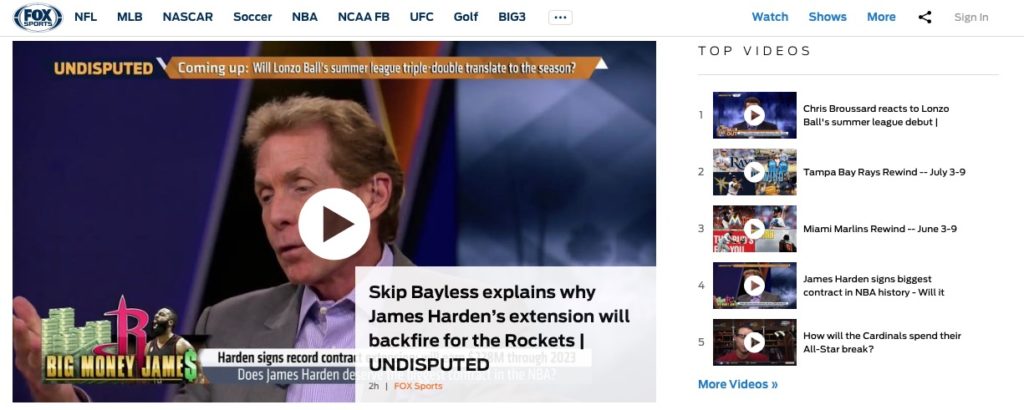Ad Disclosure
Why Sports Networks Going All In on Video Isn’t Smart
By Kyle Scott
Published:

The Ringer’s Bryan Curtis writes about what recent media outlet pivots to video – like FOX Sports laying off basically its entire web-content staff in place cheap ghostwriters to trumpet TV talking head talking points (an initiative that may be rolled back now that FOX Sports head Jamie Horowitz, the driving force behind this ridiculous shift, was fired for being a fucking creep) – actually mean for those involved and, presumably, readers:
Why this is happening is simple: The web has a surplus of copy versus advertising. Companies have decided that sticking an ad at the front of a video makes it less ignorable than putting a similar ad next to an article. It doesn’t matter what the video is. I often get a paragraph or two into a Sports Illustrated story only to find Madelyn Burke in the lower right-hand corner of the screen, giving me a summary of the sentences I’m already reading.
That is maybe the most succinct description I have seen about the prevalence of autoplay video ever. Well done.
Other writers tried to play media visionary and stepped in it. “I’ve been in digital media for 12 years,” Sports Illustrated’s Andy Gray tweeted last week. “One thing I’ve learned is that nobody wants to read anything over 1,000 words. MTV is more proof.” Never mind that Gray’s employer uses the motto “longform since 1954.”
On Twitter, Gray got the noogie he deserved. I enjoyed reading his replies. They proved that no occasion, not even an existential threat to the industry, will prevent a journalist from citing his old articles — and, in this case, also providing the word count. Why, my recent longform piece was actually quite popular!
The business elements of this shift are obvious: video ads pay more because publishers and advertisers have long bastardized the banner ad. But there is a user disconnect to all of this. Like Curtis said, it doesn’t matter what the video is, those autoplay ads are worth just the same. What I suspect will happen – or is happening – is that media outlets will learn that, surprise!, most online video isn’t as engaging as they thought, and over time that reality will hammer down those ad rates as well. Just because people watch video online, which includes everything from Netflix to Facebook, doesn’t mean they want news and sports content to be video. I consume A TON of online video, but most of it is longform programming that I used to watch on TV, or very targeted videos that I actively seek out, whether they are reviews, how-tos, or even clips from shows like Last Week Tonight. What I don’t watch with any sort of regularity are video recaps of easily readable news stories, or sports debates that were originally meant to fill hours of endless programming on TV. The bar to producing compelling online video is super high, and just throwing a couple of sweaty sports talkers on your website doesn’t drive attention or breed connections. Don’t get me wrong, it helps for reporters to be able to do more than just write. There’s a good reason why outlets have been cutting their linear, one-dimensional talent in favor of more versatile personalities, but that doesn’t mean we should just cast aside the written word.
Think about yourself right now. You’re READING this. Where are you reading it? Most likely at work, in line at the store, or on the shitter. In any of those situations, would it be easier for you to watch video? Maybe on the shitter… but most people have a problem turning up their volume at work, and most of the time text-based articles are a quick time filler on your phone in situations where you can’t watch or listen to something. The point is, just because we have shorter attention spans and like to watch video online doesn’t mean people don’t want to read stuff. I tend to bet heavy on mediums that have survived over centuries. Call me old-fashioned! The written word has somehow remained the dominant form of communication since people wrote on slabs of stone. It held its ground through the telegraph, radio, TV, the web, and so on. Sure, there are certain situations where video or audio is better. News radio broadcasts were a better wartime delivery of the news. Movies and TV shows are often better than books at telling stories (obviously there are exceptions here). ESPN highlights were better than box scores. And yet, we still read things. So I don’t think that just because people watch more online video that networks should completely abandon written words– users still want and need them in many situations. The problem is the business model.
Kyle Scott is the founder and editor of CrossingBroad.com. He has written for CBS Philly and Philly Voice, and been a panelist or contributor on NBC Sports Philly, FOX 29 and SNY TV, as well as a recurring guest on 97.5 The Fanatic, 94 WIP, 106.7 The Fan and other stations. He has more than 10 years experience running digital media properties and in online advertising and marketing.